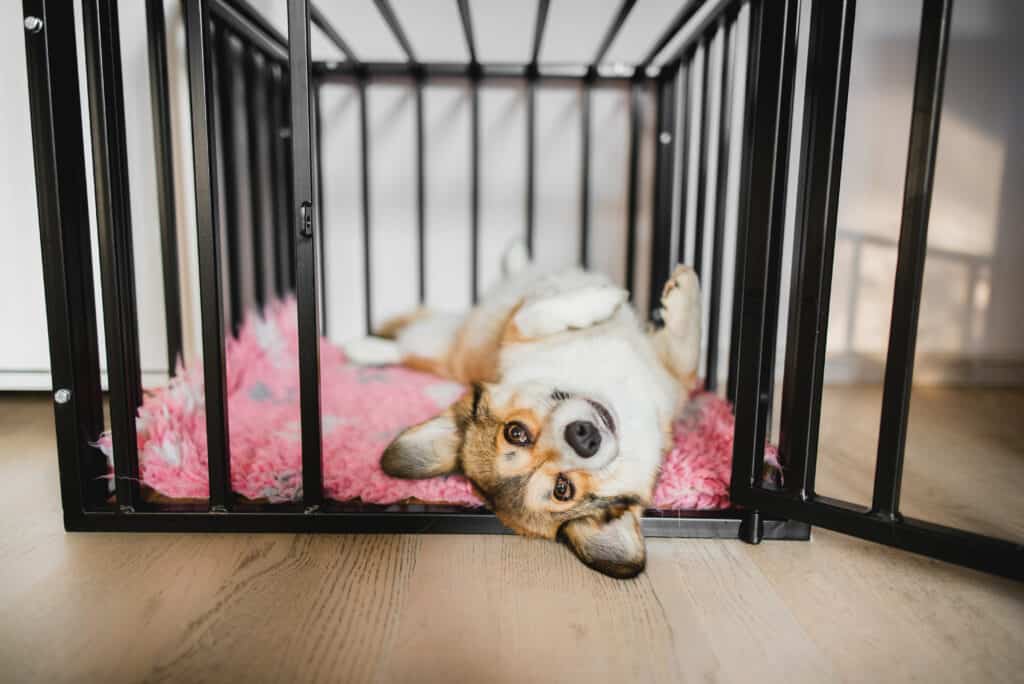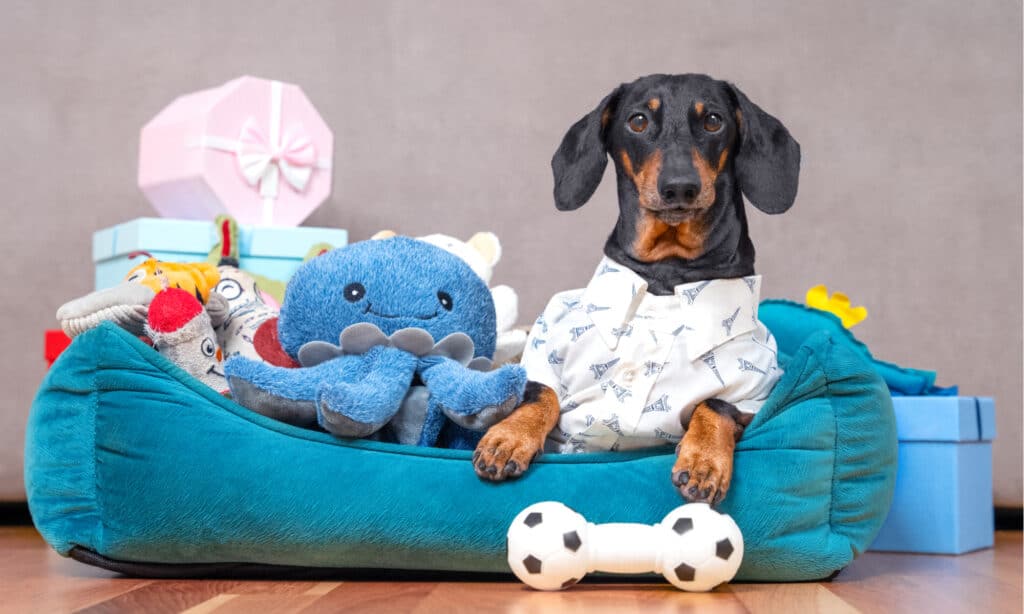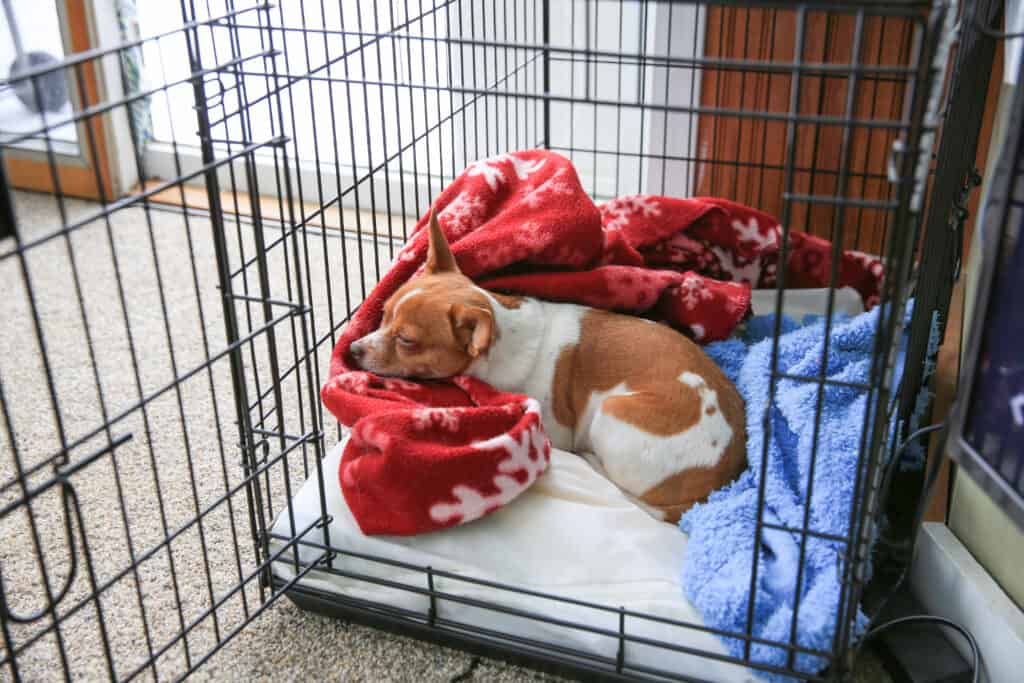Are you a proud pet parent, welcoming a new furry family member into your home? Crate training your puppy is a crucial step in ensuring a happy and harmonious relationship with your four-legged friend.
These 10 tips will get you going in the right direction to crate train your puppy during the day or at night.
In this comprehensive guide, we’ll walk you through the process of crate training and why it is important for all puppies. We’ll also offer expert tips and step-by-step instructions to make crate training a success.
Understanding Crate Training

Crate training provides a safe haven for your puppy.
©Jus_Ol/Shutterstock.com
Before diving into the nitty-gritty of crate training, let’s understand why it’s essential and how it benefits your puppy.
Why Crate Training?
Crate training provides a safe haven for your puppy, aiding in house training, preventing destructive behavior, reducing anxiety, facilitating travel, and promoting a sense of security.
Choosing the Right Crate
Select an appropriately sized crate that allows your puppy to stand, turn around, and lie down comfortably. Consider materials: wire, plastic, or soft-sided, based on your needs and your puppy’s personality.
Wire crates are typically used at home. Some are collapsible for storage when not being used.
Hard-sided plastic crates are commonly used when traveling with your larger-sized furry companion. Hard-sided crates allow dogs to travel with you on airplanes and in cars while promoting their safety. Most of them can be broken down for easy storage.
Soft-sided crates are for smaller dogs and for traveling outside the home.
Preparing for Crate Training
Now, let’s prepare for crate training with these essential steps.
Crate Placement
Place the crate in a high-traffic area where your puppy can feel part of the family but avoid direct sunlight or drafts. You can also cover the crate with a blanket to protect them from the sun and drafts.
Creating a Comfortable Environment
Add a comfortable bed or blanket for your puppy to snuggle on. Place some favorite toys inside the crate. If possible, attach a water bottle or bowl to the door of the crate. Don’t place a bowl of water in the crate; you will probably have a wet dog and wet bedding if you do.
Introduction to the Crate
Start the crate training journey on the right paw with these initial steps.
Positive Associations
Leave the crate door open during the day to let your puppy explore at their own pace. Encourage them to enter the crate by placing treats or toys inside.
Never use the crate as punishment. Make it a positive experience by offering treats and praise when they enter willingly.
Mealtime in the Crate
Begin feeding your puppy near the crate. Gradually move the food bowl closer to the crate’s entrance, then inside, to encourage them to step in.
Gradual Crate Familiarization
Now, let’s acclimate your puppy to spending more time in the crate.
Short Sessions
Start with short, positive crate sessions. Use a command like “crate” or “bed” when inviting your puppy inside.
Increasing Crate Time
Gradually extend crate time as your puppy becomes more comfortable. Reward them with praise and treats when they remain calm inside.
Crate Training for Nighttime
A good night’s sleep is crucial for both you and your puppy. Follow these steps to ensure peaceful nights.
First, establish a bedtime routine to signal it’s time for sleep. Take your puppy out for a bathroom break right before bedtime.
Then, place your puppy in the crate with their favorite toy and a soft blanket. Keep the crate near your bed, so they can hear and smell you during the night.
Gradual Independence
Gradually increase the distance between your bed and the crate. Over time, your puppy will become more comfortable sleeping alone.
Crate training during the day helps with house training and prevents boredom.
Stick to a regular potty schedule. Take your puppy out immediately after crate time to prevent accidents.
Interactive Toys

Mental stimulation is key to preventing your dogs from becoming bored.
©Masarik/Shutterstock.com
Provide engaging toys and puzzles to keep your puppy occupied. Mental stimulation is key to preventing boredom.
Handling Separation Anxiety
Puppies may experience separation anxiety. When your puppy is comfortable in their crate, they have less anxiety when you leave.
Gradual Departures
Practice leaving and returning in short increments. This desensitizes your puppy to your comings and goings. Quick trips to the mailbox, around the block, or to the convenience store ensures to your puppy that you will return.
Background Noise: Music or TV
Leaving quiet music or a television program playing when you leave also calms your dog, allowing them to settle in their crate during your absence.
Avoid Prolonged Absences
Initially, avoid leaving your puppy in the crate for extended periods. Arrange for a friend or pet sitter if needed. Experts recommend no more than 1-2 hours alone, locked in a crate, for initial crate training.
Once your puppy is comfortable in their crate, you can extend this time. You should never leave your dog confined to a crate for more than 8 hours at a time.
Crate Training Success Tips
To ensure success in crate training, consider these additional expert tips.
1. Stay Consistent – Stick to a routine. Consistency is key to successful crate training.
2. Monitor Your Puppy – Keep an eye on your puppy’s behavior while crated. Ensure they remain safe and comfortable.
3. Gradual Graduation – As your puppy matures and behaves responsibly, consider leaving the crate door open. However, keep the crate accessible as their safe space.
Troubleshooting Common Issues

Experts recommend no more than 1-2 hours alone, locked in a crate, for initial crate training.
©Jennay Hitesman/Shutterstock.com
Sometimes, challenges may arise during crate training. Here’s how to address them.
1. Whining and Barking – Avoid responding immediately to whining. Wait for a break in noise before letting your puppy out. Responding while whining only reinforces the whining – not what you want!
2. Accidents in the Crate – Clean up accidents promptly to maintain a clean environment. Using white vinegar to clean the crate will remove the odors from the crate; you can also use it in the wash when cleaning their bed and blankets. Revisit your potty training routine.
3. Crate Rejection – If your puppy resists the crate, review the above training techniques. Ensure the crate remains a positive and inviting place. The crate might become your dog’s favorite resting place.
Graduating from the Crate
Your puppy has grown, and it’s time to transition away from the crate.
Gradual Freedom
Begin by leaving your puppy out of the crate for short periods. Monitor their behavior to ensure they’re ready for more freedom.
Puppy-Proofing
Puppy-proof your home to prevent accidents and damage. Remove hazards like cords and small objects.
Provide an Alternative Space
Offer a designated area with a comfy bed where your puppy can relax. Ensure this space is secure and free from hazards.
Crate training your puppy is a journey that requires patience, consistency, and a lot of love. By following these step-by-step instructions and expert tips, you’ll create a safe and happy environment for your furry friend, ensuring a lifetime of joyful companionship.
Remember, crate training is just one step in raising a well-behaved and contented pup – enjoy the journey together!
The photo featured at the top of this post is © iStock.com/Christine McCann
Ready to discover the top 10 cutest dog breeds in the entire world?
How about the fastest dogs, the largest dogs and those that are -- quite frankly -- just the kindest dogs on the planet? Each day, AZ Animals sends out lists just like this to our thousands of email subscribers. And the best part? It's FREE. Join today by entering your email below.
Thank you for reading! Have some feedback for us? Contact the AZ Animals editorial team.







